MBS 518: Contract Law Case Study - Western Rail Liability
VerifiedAdded on 2022/10/04
|5
|893
|334
Case Study
AI Summary
This case study analyzes a contract law scenario involving Yvonne and Western Rail. The central issue revolves around the validity and application of an exclusion clause limiting the rail company's liability for lost luggage. The analysis considers whether the exclusion clause was properly incorporated into the contract through notice and signature, and whether it adheres to the contra proferentem rule. The case examines how third-party access to the bag affects liability and the impact of missing notification signs. The conclusion determines the extent of Yvonne's potential claim, considering the validity of the exclusion clause and potential claims for negligence or breach of contract, depending on the circumstances surrounding the loss of her belongings and the presence or absence of proper notifications.
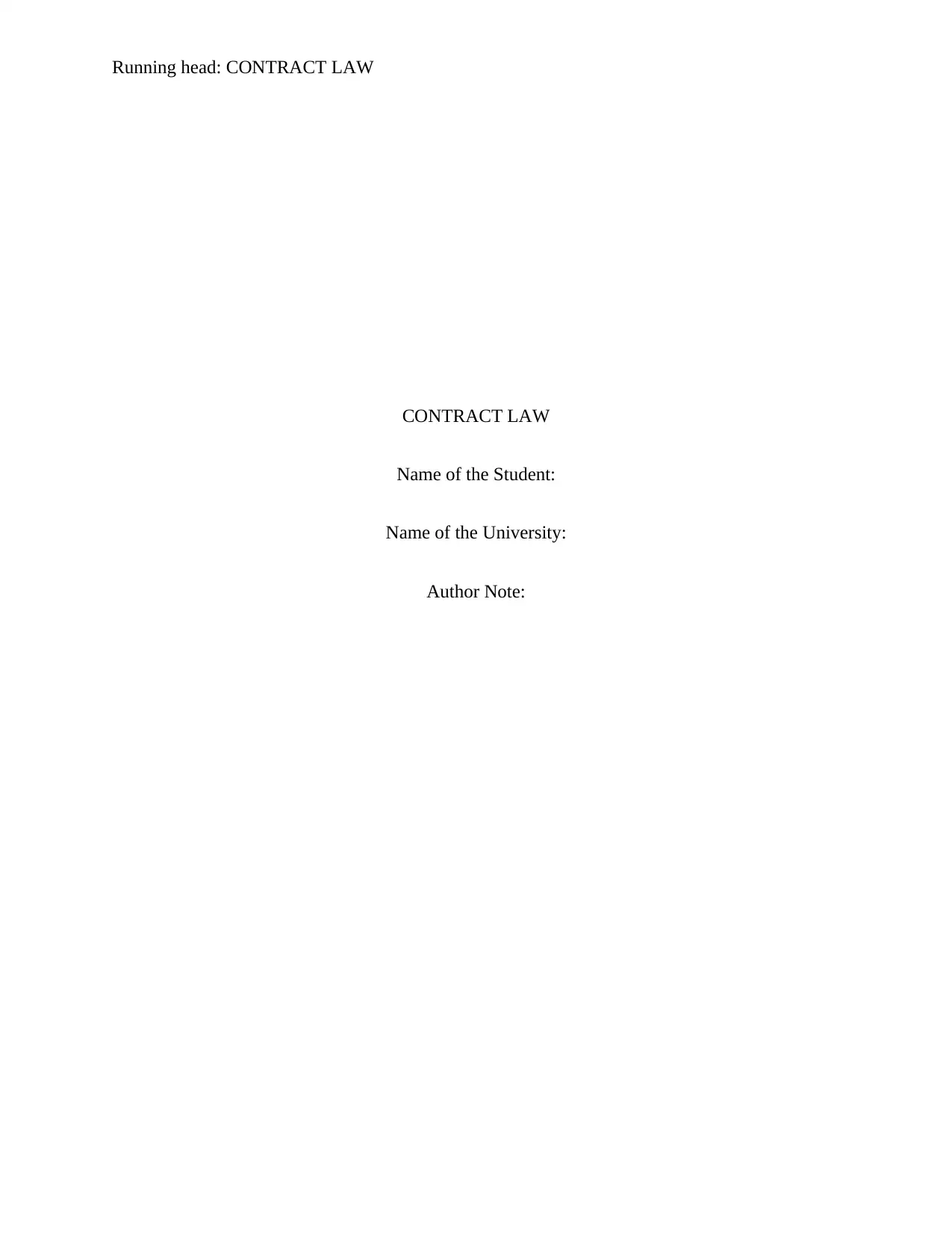
Running head: CONTRACT LAW
CONTRACT LAW
Name of the Student:
Name of the University:
Author Note:
CONTRACT LAW
Name of the Student:
Name of the University:
Author Note:
Paraphrase This Document
Need a fresh take? Get an instant paraphrase of this document with our AI Paraphraser
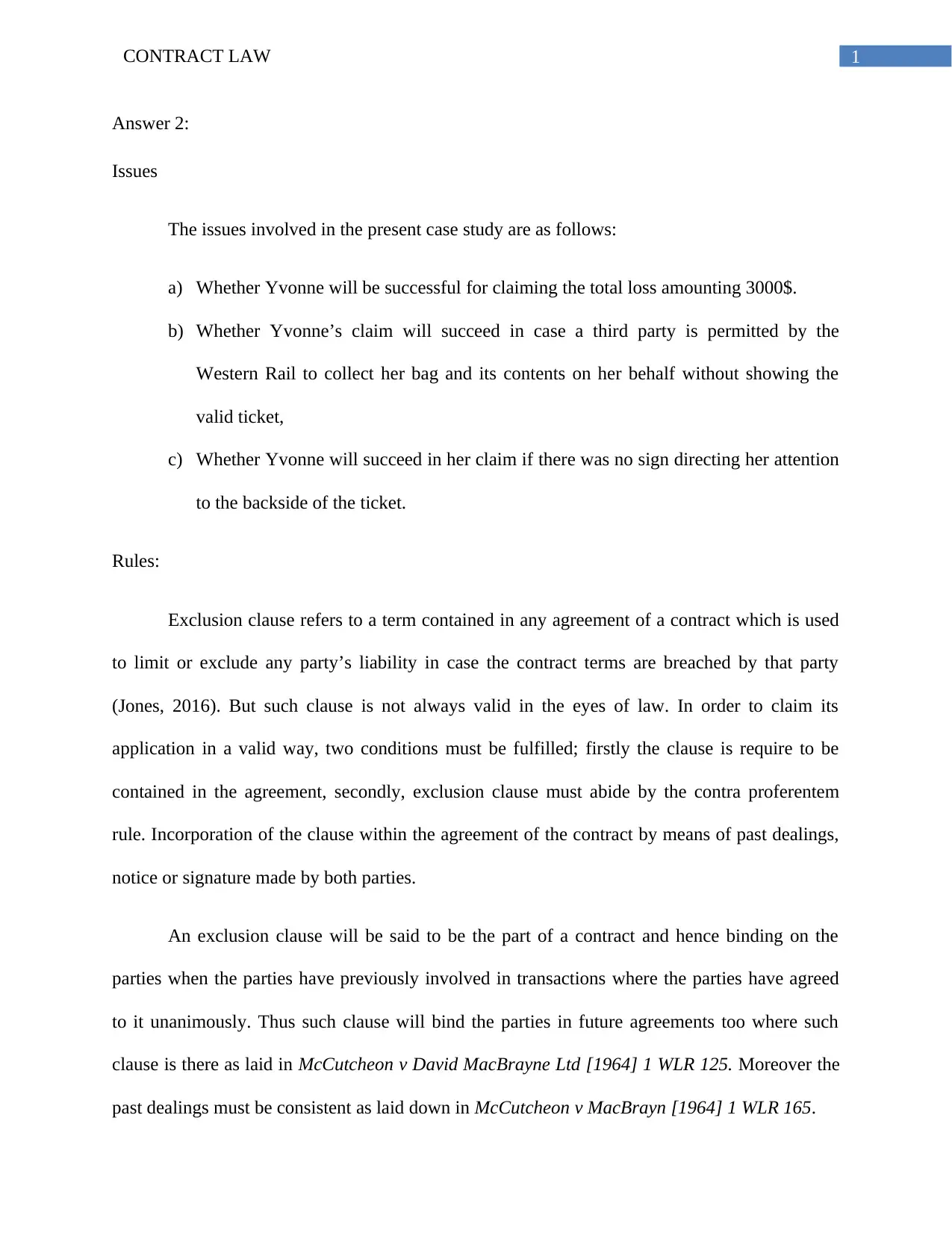
1CONTRACT LAW
Answer 2:
Issues
The issues involved in the present case study are as follows:
a) Whether Yvonne will be successful for claiming the total loss amounting 3000$.
b) Whether Yvonne’s claim will succeed in case a third party is permitted by the
Western Rail to collect her bag and its contents on her behalf without showing the
valid ticket,
c) Whether Yvonne will succeed in her claim if there was no sign directing her attention
to the backside of the ticket.
Rules:
Exclusion clause refers to a term contained in any agreement of a contract which is used
to limit or exclude any party’s liability in case the contract terms are breached by that party
(Jones, 2016). But such clause is not always valid in the eyes of law. In order to claim its
application in a valid way, two conditions must be fulfilled; firstly the clause is require to be
contained in the agreement, secondly, exclusion clause must abide by the contra proferentem
rule. Incorporation of the clause within the agreement of the contract by means of past dealings,
notice or signature made by both parties.
An exclusion clause will be said to be the part of a contract and hence binding on the
parties when the parties have previously involved in transactions where the parties have agreed
to it unanimously. Thus such clause will bind the parties in future agreements too where such
clause is there as laid in McCutcheon v David MacBrayne Ltd [1964] 1 WLR 125. Moreover the
past dealings must be consistent as laid down in McCutcheon v MacBrayn [1964] 1 WLR 165.
Answer 2:
Issues
The issues involved in the present case study are as follows:
a) Whether Yvonne will be successful for claiming the total loss amounting 3000$.
b) Whether Yvonne’s claim will succeed in case a third party is permitted by the
Western Rail to collect her bag and its contents on her behalf without showing the
valid ticket,
c) Whether Yvonne will succeed in her claim if there was no sign directing her attention
to the backside of the ticket.
Rules:
Exclusion clause refers to a term contained in any agreement of a contract which is used
to limit or exclude any party’s liability in case the contract terms are breached by that party
(Jones, 2016). But such clause is not always valid in the eyes of law. In order to claim its
application in a valid way, two conditions must be fulfilled; firstly the clause is require to be
contained in the agreement, secondly, exclusion clause must abide by the contra proferentem
rule. Incorporation of the clause within the agreement of the contract by means of past dealings,
notice or signature made by both parties.
An exclusion clause will be said to be the part of a contract and hence binding on the
parties when the parties have previously involved in transactions where the parties have agreed
to it unanimously. Thus such clause will bind the parties in future agreements too where such
clause is there as laid in McCutcheon v David MacBrayne Ltd [1964] 1 WLR 125. Moreover the
past dealings must be consistent as laid down in McCutcheon v MacBrayn [1964] 1 WLR 165.
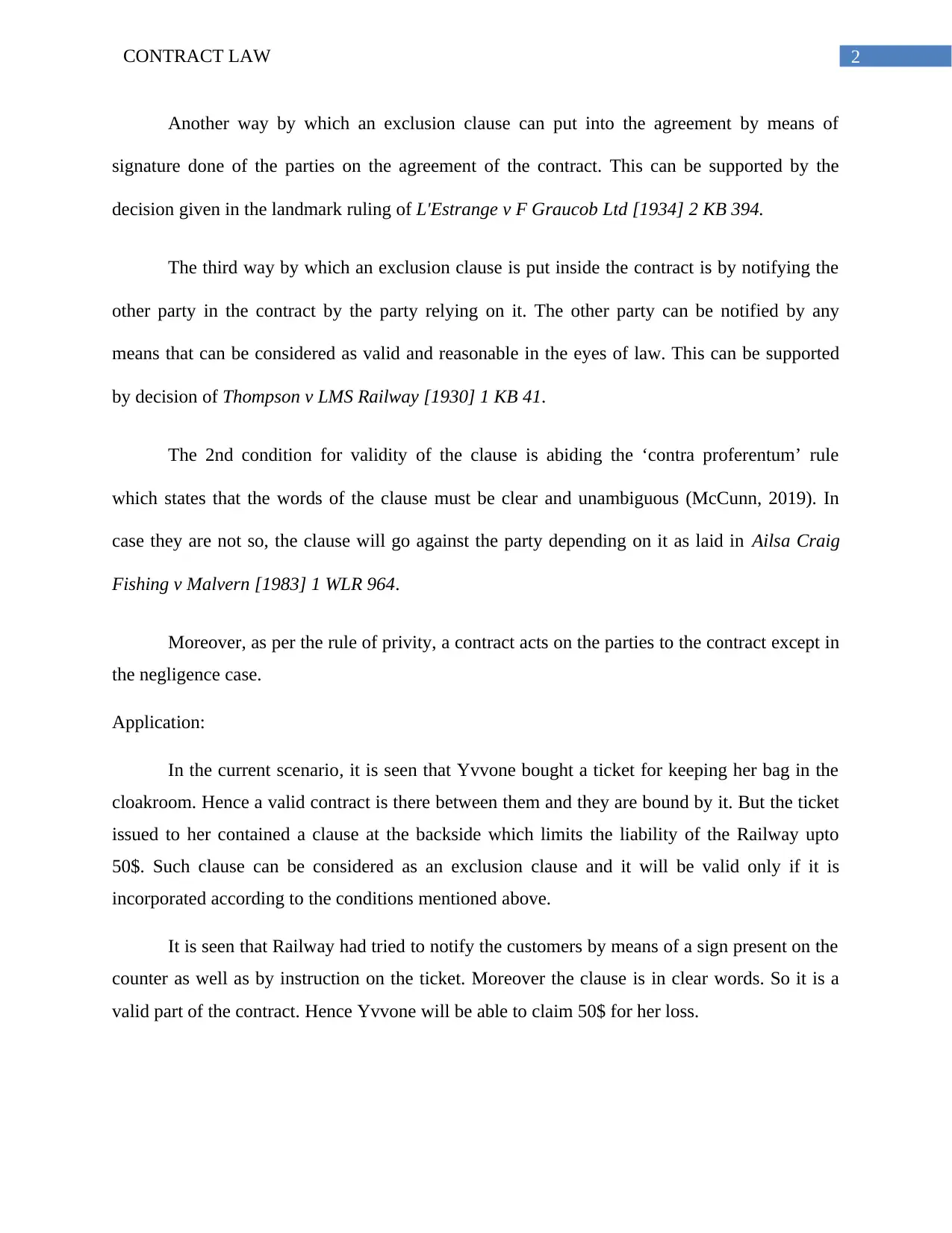
2CONTRACT LAW
Another way by which an exclusion clause can put into the agreement by means of
signature done of the parties on the agreement of the contract. This can be supported by the
decision given in the landmark ruling of L'Estrange v F Graucob Ltd [1934] 2 KB 394.
The third way by which an exclusion clause is put inside the contract is by notifying the
other party in the contract by the party relying on it. The other party can be notified by any
means that can be considered as valid and reasonable in the eyes of law. This can be supported
by decision of Thompson v LMS Railway [1930] 1 KB 41.
The 2nd condition for validity of the clause is abiding the ‘contra proferentum’ rule
which states that the words of the clause must be clear and unambiguous (McCunn, 2019). In
case they are not so, the clause will go against the party depending on it as laid in Ailsa Craig
Fishing v Malvern [1983] 1 WLR 964.
Moreover, as per the rule of privity, a contract acts on the parties to the contract except in
the negligence case.
Application:
In the current scenario, it is seen that Yvvone bought a ticket for keeping her bag in the
cloakroom. Hence a valid contract is there between them and they are bound by it. But the ticket
issued to her contained a clause at the backside which limits the liability of the Railway upto
50$. Such clause can be considered as an exclusion clause and it will be valid only if it is
incorporated according to the conditions mentioned above.
It is seen that Railway had tried to notify the customers by means of a sign present on the
counter as well as by instruction on the ticket. Moreover the clause is in clear words. So it is a
valid part of the contract. Hence Yvvone will be able to claim 50$ for her loss.
Another way by which an exclusion clause can put into the agreement by means of
signature done of the parties on the agreement of the contract. This can be supported by the
decision given in the landmark ruling of L'Estrange v F Graucob Ltd [1934] 2 KB 394.
The third way by which an exclusion clause is put inside the contract is by notifying the
other party in the contract by the party relying on it. The other party can be notified by any
means that can be considered as valid and reasonable in the eyes of law. This can be supported
by decision of Thompson v LMS Railway [1930] 1 KB 41.
The 2nd condition for validity of the clause is abiding the ‘contra proferentum’ rule
which states that the words of the clause must be clear and unambiguous (McCunn, 2019). In
case they are not so, the clause will go against the party depending on it as laid in Ailsa Craig
Fishing v Malvern [1983] 1 WLR 964.
Moreover, as per the rule of privity, a contract acts on the parties to the contract except in
the negligence case.
Application:
In the current scenario, it is seen that Yvvone bought a ticket for keeping her bag in the
cloakroom. Hence a valid contract is there between them and they are bound by it. But the ticket
issued to her contained a clause at the backside which limits the liability of the Railway upto
50$. Such clause can be considered as an exclusion clause and it will be valid only if it is
incorporated according to the conditions mentioned above.
It is seen that Railway had tried to notify the customers by means of a sign present on the
counter as well as by instruction on the ticket. Moreover the clause is in clear words. So it is a
valid part of the contract. Hence Yvvone will be able to claim 50$ for her loss.
⊘ This is a preview!⊘
Do you want full access?
Subscribe today to unlock all pages.

Trusted by 1+ million students worldwide
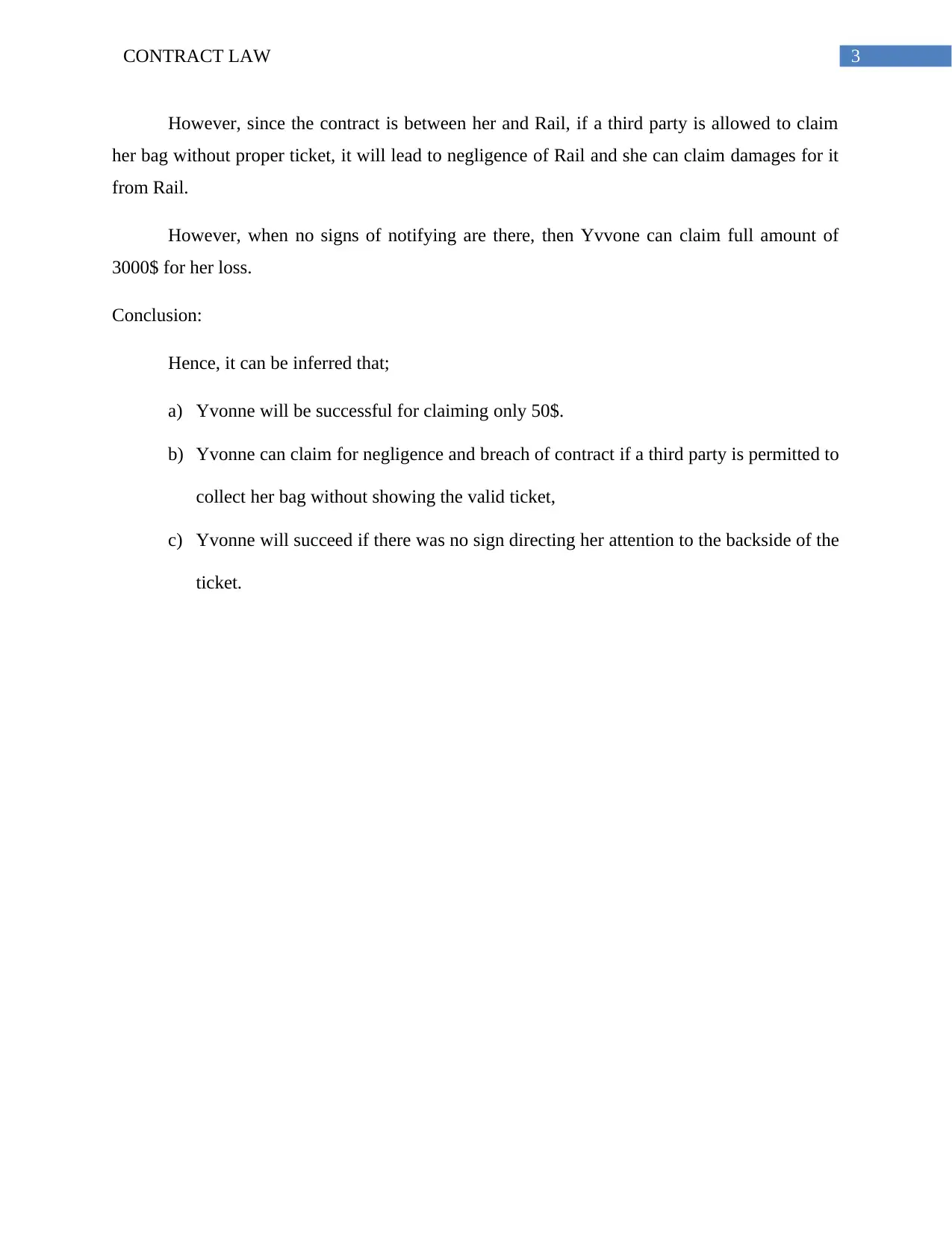
3CONTRACT LAW
However, since the contract is between her and Rail, if a third party is allowed to claim
her bag without proper ticket, it will lead to negligence of Rail and she can claim damages for it
from Rail.
However, when no signs of notifying are there, then Yvvone can claim full amount of
3000$ for her loss.
Conclusion:
Hence, it can be inferred that;
a) Yvonne will be successful for claiming only 50$.
b) Yvonne can claim for negligence and breach of contract if a third party is permitted to
collect her bag without showing the valid ticket,
c) Yvonne will succeed if there was no sign directing her attention to the backside of the
ticket.
However, since the contract is between her and Rail, if a third party is allowed to claim
her bag without proper ticket, it will lead to negligence of Rail and she can claim damages for it
from Rail.
However, when no signs of notifying are there, then Yvvone can claim full amount of
3000$ for her loss.
Conclusion:
Hence, it can be inferred that;
a) Yvonne will be successful for claiming only 50$.
b) Yvonne can claim for negligence and breach of contract if a third party is permitted to
collect her bag without showing the valid ticket,
c) Yvonne will succeed if there was no sign directing her attention to the backside of the
ticket.
Paraphrase This Document
Need a fresh take? Get an instant paraphrase of this document with our AI Paraphraser
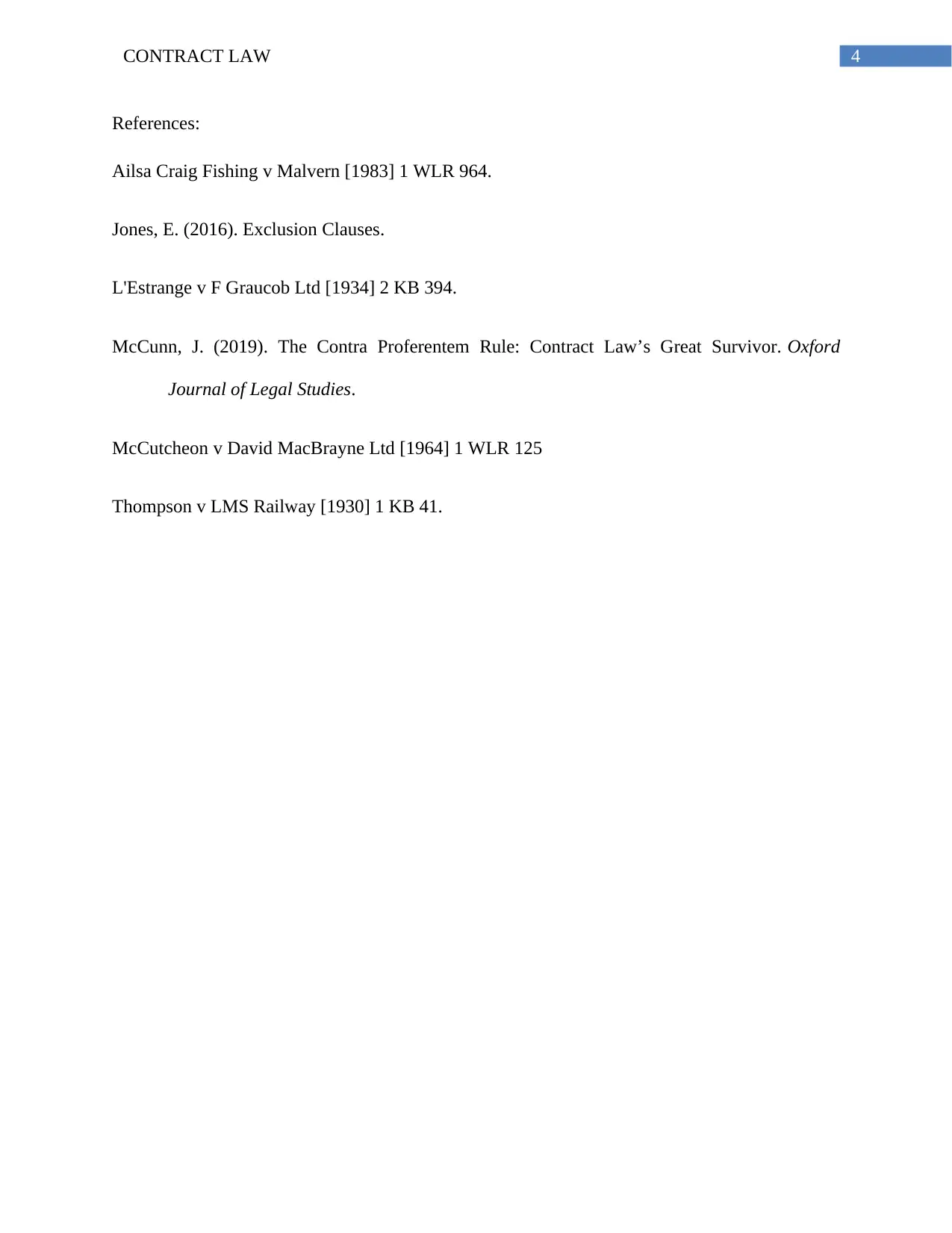
4CONTRACT LAW
References:
Ailsa Craig Fishing v Malvern [1983] 1 WLR 964.
Jones, E. (2016). Exclusion Clauses.
L'Estrange v F Graucob Ltd [1934] 2 KB 394.
McCunn, J. (2019). The Contra Proferentem Rule: Contract Law’s Great Survivor. Oxford
Journal of Legal Studies.
McCutcheon v David MacBrayne Ltd [1964] 1 WLR 125
Thompson v LMS Railway [1930] 1 KB 41.
References:
Ailsa Craig Fishing v Malvern [1983] 1 WLR 964.
Jones, E. (2016). Exclusion Clauses.
L'Estrange v F Graucob Ltd [1934] 2 KB 394.
McCunn, J. (2019). The Contra Proferentem Rule: Contract Law’s Great Survivor. Oxford
Journal of Legal Studies.
McCutcheon v David MacBrayne Ltd [1964] 1 WLR 125
Thompson v LMS Railway [1930] 1 KB 41.
1 out of 5
Related Documents
Your All-in-One AI-Powered Toolkit for Academic Success.
+13062052269
info@desklib.com
Available 24*7 on WhatsApp / Email
![[object Object]](/_next/static/media/star-bottom.7253800d.svg)
Unlock your academic potential
Copyright © 2020–2025 A2Z Services. All Rights Reserved. Developed and managed by ZUCOL.




